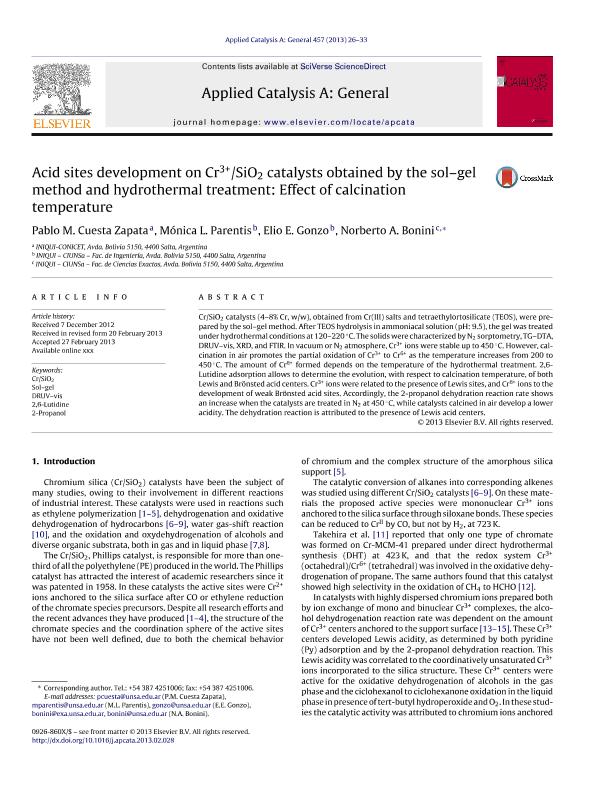Artículo
Acid sites development on Cr3+/SiO2 catalysts obtained by the sol-gel method and hydrothermal treatment: Effect of calcination temperature
Cuesta Zapata, Pablo Martín ; Parentis, Monica Liliana; Gonzo, Elio Emilio
; Parentis, Monica Liliana; Gonzo, Elio Emilio ; Bonini, Norberto Alejandro
; Bonini, Norberto Alejandro
 ; Parentis, Monica Liliana; Gonzo, Elio Emilio
; Parentis, Monica Liliana; Gonzo, Elio Emilio ; Bonini, Norberto Alejandro
; Bonini, Norberto Alejandro
Fecha de publicación:
24/04/2013
Editorial:
Elsevier Science
Revista:
Applied Catalysis A: General
ISSN:
0926-860X
Idioma:
Inglés
Tipo de recurso:
Artículo publicado
Clasificación temática:
Resumen
Cr/SiO2 catalysts (4-8% Cr, w/w), obtained from Cr(III) salts and tetraethylortosilicate (TEOS), were prepared by the sol-gel method. After TEOS hydrolysis in ammoniacal solution (pH: 9.5), the gel was treated under hydrothermal conditions at 120-220 C. The solids were characterized by N 2 sorptometry, TG-DTA, DRUV-vis, XRD, and FTIR. In vacuum or N 2 atmosphere, Cr3+ ions were stable up to 450 C. However, calcination in air promotes the partial oxidation of Cr3+ to Cr 6+ as the temperature increases from 200 to 450 C. The amount of Cr6+ formed depends on the temperature of the hydrothermal treatment. 2,6-Lutidine adsorption allows to determine the evolution, with respect to calcination temperature, of both Lewis and Brönsted acid centers. Cr 3+ ions were related to the presence of Lewis sites, and Cr 6+ ions to the development of weak Brönsted acid sites. Accordingly, the 2-propanol dehydration reaction rate shows an increase when the catalysts are treated in N2 at 450 C, while catalysts calcined in air develop a lower acidity. The dehydration reaction is attributed to the presence of Lewis acid centers.
Palabras clave:
Cr/Sio2
,
Sol-Gel
,
2,6-Lutidine
,
Druv-Vis
Archivos asociados
Licencia
Identificadores
Colecciones
Articulos(INIQUI)
Articulos de INST.DE INVEST.PARA LA INDUSTRIA QUIMICA (I)
Articulos de INST.DE INVEST.PARA LA INDUSTRIA QUIMICA (I)
Citación
Cuesta Zapata, Pablo Martín; Parentis, Monica Liliana; Gonzo, Elio Emilio; Bonini, Norberto Alejandro; Acid sites development on Cr3+/SiO2 catalysts obtained by the sol-gel method and hydrothermal treatment: Effect of calcination temperature; Elsevier Science; Applied Catalysis A: General; 457; 24-4-2013; 26-33
Compartir
Altmétricas



